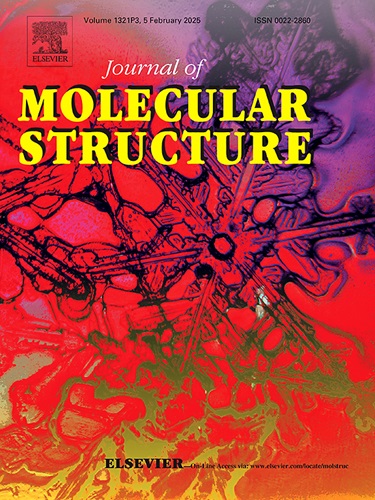PPTS-catalyzed metal-free synthesis of poly-substituted pyridines: their in silico / in vitro evaluation against SIRT1
IF 4
2区 化学
Q2 CHEMISTRY, PHYSICAL
引用次数: 0
Abstract
The poly-substituted pyridine derivatives were explored as potential inhibitors of SIRT1. One-pot synthesis of these compounds was carried out via PPTS-catalyzed 3-component reaction (3-CR) of β-keto esters (or 1,3-diketones), 2-ylidenemalononitriles and anilines. This metal-free reaction proceeded in aqueous EtOH at room temperature to give the desired product within 3 h. A variety of reactants was employed in this environmentally friendly 3-CR where water seemed to be the only by-product. This straightforward and easy to operate methodology provided a series of desired products in good to high (85-92%) yields. A majority of these compounds showed good interactions with a number of residues when docked into SIRT1 in silico. Most of them including the top three molecules in terms of binding affinity i.e. 4c, 4e and 4k participated in the key H-bonds with ILE347 and ASP348 via their –CN moiety. Indeed, a comparison of the active site and binding poses of 4c, 4e and 4k along with native ligand EX527a in SIRT1 showed that they were aligned well. The high binding affinity of 4e was aided by its participation in two H-bonds with ILE347 and ASP348 via its CN moiety and three H-bonding with GLY319 and GLN320 through its NO2 group. The in silico studies also predicted probable selectivity of 4c, 4e and 4k towards SIRT1 over SIRT2. When tested in vitro at 10 µM, these three compounds showed encouraging inhibition of SIRT1 (IC50 ∼ 2.7-3.5 µM) when 4e emerged as the best active molecule. According to the SAR analysis, the promising activities were observed when the aryl group at C-4 was chosen as the 4-NCC6H4 or 4-O2NC6H4 moiety, the group at C-3 was –CO2Et and the amine substituent at C-6 was 2-MeC6H4NH- moiety. However, an i-butyl group at C-4 was found to be less effective. Based on in silico and in vitro studies along with ADME predictions the compound 4c, 4e and 4k were identified as preliminary hits for further pharmacological evaluation.
ppts催化的无金属多取代吡啶合成:对SIRT1的硅/体外评价
研究了多取代吡啶衍生物作为SIRT1的潜在抑制剂。这些化合物是通过ppts催化β-酮酯(或1,3-二酮)、2-酰基二酮腈和苯胺的3组分反应(3-CR)一锅合成的。这种无金属的反应在室温下的EtOH水溶液中进行,在3小时内得到所需的产物。在这种环境友好的3- cr中使用了各种反应物,而水似乎是唯一的副产物。该方法简单、易于操作,可提供一系列收率高(85-92%)的理想产品。当在硅中与SIRT1对接时,这些化合物中的大多数与许多残基表现出良好的相互作用。包括结合亲合力排名前三的4c、4e和4k分子在内的大多数分子通过-CN片段参与了与ILE347和ASP348的关键氢键。事实上,将4c、4e和4k与SIRT1中的天然配体EX527a的活性位点和结合姿态进行比较,发现它们是很好的对齐。4e与ILE347和ASP348的两个氢键通过其CN基团参与,与GLY319和GLN320的三个氢键通过其NO2基团参与,有助于其高结合亲和力。计算机研究还预测了4c、4e和4k对SIRT1的选择性超过SIRT2。在体外10µM条件下,这三种化合物表现出令人鼓舞的SIRT1抑制作用(IC50 ~ 2.7-3.5µM),其中4e表现出最好的活性分子。根据SAR分析,选择C-4上的芳基作为4-NCC6H4或4-O2NC6H4基团,C-3上的基团为- co2et, C-6上的胺取代基为2- mec6h4nh4 -基团时,活性较好。然而,C-4上的i-丁基被发现效果较差。基于计算机和体外研究以及ADME预测,化合物4c, 4e和4k被确定为进一步药理评估的初步目标。
本文章由计算机程序翻译,如有差异,请以英文原文为准。
求助全文
约1分钟内获得全文
求助全文
来源期刊

Journal of Molecular Structure
化学-物理化学
CiteScore
7.10
自引率
15.80%
发文量
2384
审稿时长
45 days
期刊介绍:
The Journal of Molecular Structure is dedicated to the publication of full-length articles and review papers, providing important new structural information on all types of chemical species including:
• Stable and unstable molecules in all types of environments (vapour, molecular beam, liquid, solution, liquid crystal, solid state, matrix-isolated, surface-absorbed etc.)
• Chemical intermediates
• Molecules in excited states
• Biological molecules
• Polymers.
The methods used may include any combination of spectroscopic and non-spectroscopic techniques, for example:
• Infrared spectroscopy (mid, far, near)
• Raman spectroscopy and non-linear Raman methods (CARS, etc.)
• Electronic absorption spectroscopy
• Optical rotatory dispersion and circular dichroism
• Fluorescence and phosphorescence techniques
• Electron spectroscopies (PES, XPS), EXAFS, etc.
• Microwave spectroscopy
• Electron diffraction
• NMR and ESR spectroscopies
• Mössbauer spectroscopy
• X-ray crystallography
• Charge Density Analyses
• Computational Studies (supplementing experimental methods)
We encourage publications combining theoretical and experimental approaches. The structural insights gained by the studies should be correlated with the properties, activity and/ or reactivity of the molecule under investigation and the relevance of this molecule and its implications should be discussed.
 求助内容:
求助内容: 应助结果提醒方式:
应助结果提醒方式:


